1. Background analysis of candidates in the Parliamentary elections 2019
The following review examines persons entitled to vote in the Parliamentary elections 2019 and the candidates nominated by the parties according to various background information. The data on persons entitled to vote derive from the voting register established on 22 February 2019 and the data on the candidates from the candidate register set up on 14 March 2019. The background data are based on statistical data from Statistics Finland, such as population, employment and family statistics and the Register of Completed Education and Degrees. Of the persons entitled to vote only those resident in Finland are included in the review. The parties that got candidates elected into parliament in the 2015 Parliamentary elections are presented in the Figures and Tables, and in the analysis they are called "Parliamentary parties". This also includes the Blue Reform that separated from the Finns Party. The data on the candidates of other parties and constituency associations are summed under the group "Others".
The candidates differ by age structure and sex from all persons entitled to vote. Considerably fewer of the candidates are aged 30 or under and 70 or over than the persons entitled to vote, and more of the candidates are men than women. This should be taken into consideration when comparing the candidates with persons entitled to vote. In the tables and figures of this analysis, the data are not age-standardised. Standardisation would slightly lower the difference between the candidates and those entitled to vote, for example, when comparing the level of education, main type of activity, family status and socio-economic group among the candidates and persons entitled to vote.
1.1. Summary
Women's share of the candidates rose to over 40 per centThe total number of candidates nominated in the Parliamentary elections is 2,468, which is 322 more candidates than in the previous elections and more than ever in the 2000s. Of the candidates, 1,432 are men and 1,036 are women. In all elections in the 2000s, women's share of candidates has been just under 40 per cent. Now women's share rose to 42 per cent – the share having risen by 2.6 percentage points from the previous elections. Of the parliamentary parties, the Finns Party (31.5%) and the Blue Reform (32.9%) nominated in relative terms the least female candidates. The share of women candidates is highest in the Green League (62.0%). In addition to the Green League, the Swedish People's Party and the Christian Democrats have more female than male candidates. In constituencies, women's share is biggest in Uusimaa (44%) and smallest in Vaasa (37%).
Nearly one third also ran in the previous electionsNearly 30 per cent of the candidates were also nominated in the 2015 elections. Among the parliamentary parties, the Finnish Social Democratic Party has most of the same candidates in the elections compared to the previous elections, over 40 per cent. The Swedish People's Party (23.5%) and the Green League (29.6%) have least of the same candidates. Around 16 per cent of the Blue Reform candidates were candidates of the Finns Party in the 2015 elections.
Of the parliamentary parties, the Blue Reform has the oldest candidates, the Green League the youngestCandidates are, on average, 4.3 years younger than persons entitled to vote. The average age of the candidates is 46.9 years and that of persons entitled to vote 51.2 years. Of the parliamentary parties, the Blue Reform has the oldest candidates: the average age of its candidates is 54.4 years and around 38 per cent of the candidates are aged 60 or over. The candidates of the Green League are in turn youngest in their average age. Around 15 per cent of them are aged under 30, and the average age of the candidates is 41.3 years.
In all, 2.4 per cent of the candidates are of foreign originThe share of candidates of foreign origin is on the same level as among persons entitled to vote, around 2.5 per cent. The proportion of persons of foreign origin among everyone living in Finland is, however, higher, as only Finnish citizens are entitled to vote and eligible to stand as candidates in the Parliamentary elections. For example, around seven per cent of the population living in Finland were of foreign origin in 2017. Of the parliamentary parties, the Social Democrats and the Left Alliance have the most candidates of foreign origin, slightly over four per cent and the Finns Party the least, around half a per cent of candidates.
Candidates are more highly educated and more often in working lifeNearly one-half of the candidates have tertiary level qualifications. The corresponding share is slightly under one quarter among persons entitled to vote. Under ten per cent of the candidates have only basic level education, but around one-quarter of persons entitled to vote. This is partly explained by the different age structure of people entitled to vote and the candidates. The candidates of the Green League and the National Coalition Party have the highest level of education, one-half of them have higher tertiary or doctorate level degrees.
The difference in the age structure between the candidates and persons entitled to vote is also reflected in the difference between the labour market position of candidates and persons entitled to vote: over 70 per cent of candidates are employed and slightly over one-half of those entitled to vote. Nearly one-third of persons entitled to vote are pensioners, but only every tenth of the candidates. The employment rate is calculated from the working-age population aged 18 to 64. The employment rate of the candidates is 78 per cent, while that of persons entitled to vote is around ten percentage points lower.
By their socio-economic group, more candidates are salaried employees than persons entitled to vote: 70 per cent of the candidates and around 59 per cent of employed persons entitled to vote belong to salaried employees. For all parliamentary parties, the proportion of salaried employees is higher among candidates than among persons entitled to vote.
Of employed candidates, 43 per cent work in the public sector. Roughly the same proportion of candidates and persons entitled to vote work in the local government sector but the central government sector employs clearly more MP candidates than persons entitled to vote. When slightly over five per cent of all persons entitled to vote are working in the central government sector, this is so for around 18 per cent of the candidates.
One-quarter of persons entitled to vote and one-fifth of candidates live aloneThe candidates also differ in their family status from persons entitled to vote: considerably more of them are parents of a family with children and clearly fewer are childless couples than is the case among persons entitled to vote. This is already explained by the younger age groups of candidates compared to persons entitled to vote. Of all persons entitled to vote, 22 per cent are parents of families with children, good one-third of the candidates. One-quarter of persons entitled to vote live alone, but only slightly over one-fifth of the candidates.
Family status does not reveal how many of the candidates have or have had children of their own, because in older families, children may have already moved away from home and in family break-ups, children may live with their other parent. This can, however, be examined based on the number of children recorded in the Finnish Population Information System. Candidates have somewhat more children than average. Of the candidates, 70 per cent have children of their own, whereas the corresponding figure for persons entitled to vote is 66 per cent. The candidates have 1.7 children, on average, and persons entitled to vote have 1.5 children.
Highest income level among Coalition Party candidatesCandidates are more highly educated and a larger share of them are also working than among persons entitled to vote. This largely accounts for the higher income level of candidates than persons entitled to vote. The median disposable income of the candidates is EUR 29,100 and that of all persons entitled to vote EUR 21,500. The candidates' disposable income is about 36 per cent higher than that of persons entitled to vote.
The candidates’ income varies by party from around EUR 47,500 in the Coalition Party to EUR 26,300 in the Blue Reform. The highest income decile of the population entitled to vote has at least EUR 39,600 at their disposal and the lowest income decile at most EUR 9,400. Of all candidates, 27 per cent belong to the highest income decile. Of the candidates, those representing the National Coalition Party and the Centre Party belong to the higher end of the income distribution. Around 62 per cent of the Coalition Party candidates and one-half of the Centre Party candidates belong to the highest income decile.
1.2. Candidates and persons entitled to vote by sex
Women’s share of candidates 42 per cent
The total number of candidates nominated in the Parliamentary elections is 2,468, which is 322 more candidates than in the previous election and more than ever in the 2000s. Four parties, that is, the Centre Party, the Social Democratic Party, the Left Alliance and the Green League nominated the maximum number of candidates, which is 216. The number of Finns Party candidates was on level with the previous time even though the Blue Reform that separated from the Finns Party now nominated 152 candidates.
Table 1. Number of candidates by party in Parliamentary elections 2011, 2015 and 2019
| Number of candidates by party | Change from the previous elections, (%) | ||||
| 2011 | 2015 | 2019 | 2015 | 2019 | |
| Candidates total | 2,315 | 2,146 | 2,468 | -7.3 | 15.0 |
| Centre Party of Finland KESK | 233 | 216 | 216 | -7.3 | 0.0 |
| Finns Party PS | 238 | 215 | 213 | -9.7 | -0.9 |
| National Coalition Party KOK | 232 | 214 | 211 | -7.8 | -1.4 |
| Finnish Social Democratic Party SDP | 238 | 216 | 216 | -9.2 | 0.0 |
| Green League VIHR | 228 | 208 | 216 | -8.8 | 3.8 |
| Left Alliance VAS | 236 | 216 | 216 | -8.5 | 0.0 |
| Swedish People’s Party in Finland RKP | 83 | 104 | 98 | 25.3 | -5.8 |
| Christian Democrats in Finland KD | 191 | 193 | 190 | 1.0 | -1.6 |
| Blue Reform SIN | - | - | 152 | - | - |
| Others | 636 | 564 | 740 | -11.3 | 31.2 |
Of the candidates, 1,432 are men and 1,036 are women. Women's share of candidates is now 42 per cent, the share having grown by 2.6 percentage points from the previous elections. Among the major parliamentary parties, the Finns Party (31.5%) and the Blue Reform (32.9%) nominated the least female candidates in the 2019 elections. The Green League (62.0%) and the Swedish People's Party (53.1%) have the highest shares of female candidates. In addition to them, the Christian Democrats in Finland have more female than male candidates (51.1%). A majority, or 51.4 per cent, of the persons entitled to vote are women.
Figure 1. Persons entitled to vote and candidates (by party) by sex in Parliamentary elections 2019, %
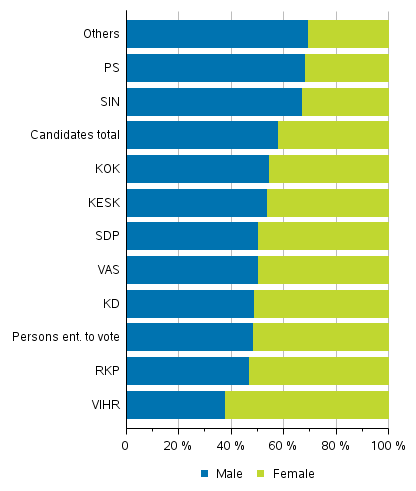
Women's share of candidates in the Parliamentary elections now rose for the first time in the 2000s to over 40 per cent. Women’s share of candidates is higher than in the previous elections for all other parties except the Coalition Party and the Finns Party. The share of female candidates fell in the Coalition Party by 0.8 percentage points and in the Finns Party by 3.8 percentage points. The Blue Reform also nominated fewer women as its candidates (32.9%) than the Finns Party in the 2015 elections. The share of female candidates rose most in the Swedish People's Party (by 8.9 percentage points) and in the Centre Party (by 6.5 percentage points).
Table 2. Women's proportion of persons entitled to vote and candidates (by party) in Parliamentary elections 2007, 2011, 2015 and 2019, %
| 2007 | 2011 | 2015 | 2019 | |
| Persons ent. to vote | 51.6 | 51.6 | 51.5 | 51.4 |
| Candidates total | 39.9 | 39.0 | 39.4 | 42.0 |
| Centre Party of Finland KESK | 43.8 | 41.2 | 39.8 | 46.3 |
| Finns Party PS | 25.0 | 33.2 | 35.3 | 31.5 |
| National Coalition Party KOK | 44.0 | 44.8 | 46.3 | 45.5 |
| Finnish Social Democratic Party SDP | 49.1 | 43.3 | 47.2 | 49.5 |
| Green League VIHR | 52.5 | 51.8 | 56.3 | 62.0 |
| Left Alliance VAS | 45.7 | 43.6 | 43.1 | 49.5 |
| Swedish People’s Party in Finland RKP | 45.3 | 44.6 | 44.2 | 53.1 |
| Christian Democrats in Finland KD | 39.4 | 42.9 | 45.6 | 51.1 |
| Blue Reform SIN | - | - | - | 32.9 |
| Others | 28.2 | 28.5 | 24.5 | 30.5 |
In the 2019 elections, the smallest share of women candidates are found in the constituency of Vaasa, around 37 per cent. It is the only constituency where women's share of candidates is under 40 per cent. In the constituency of Vaasa, the share of female candidates has remained unchanged since 2007.
In Mainland Finland constituencies, the share of female candidates is highest in Uusimaa, where 44 per cent of the candidates were women. There are also more women than average among candidates in the constituencies of Central Finland, Oulu, Häme and Varsinais-Suomi. Compared with the previous elections, women's share of candidates grew most in Lapland (by 4.6 percentage points), Uusimaa (by 4.5 percentage points) and Pirkanmaa (by 4.4 percentage points):
Two of the five candidates in the constituency of Åland are women, i.e. 40 per cent.
The majority, 51.4 per cent, of the persons entitled to vote are women. The female majority is biggest in the constituency of Helsinki, where 54.2 per cent of the persons entitled to vote are women. The Oulu constituency is the only one where women's share of persons entitled to vote is under 50 per cent.
The underrepresentation of women among candidates is largest in the constituencies of Vaasa and Helsinki, where there are 13 percentage points fewer women candidates than their share of persons entitled to vote. This difference is smallest in the constituencies of Oulu, Central Finland and Uusimaa, six to seven percentage points.
Table 3. Proportion of women of candidates by constituency in Parliamentary elections, 2011, 2015 and 2019, % 1)
| 2011 | 2015 | 2019 | |
| Candidates | Candidates | Candidates | |
| Whole country | 39.0 | 39.4 | 42.0 |
| Helsinki | 40.8 | 41.3 | 41.3 |
| Uusimaa | 40.9 | 39.6 | 44.1 |
| Varsinais-Suomi | 40.3 | 41.0 | 42.4 |
| Satakunta | 40.2 | 38.1 | 40.2 |
| Häme | 38.6 | 42.5 | 43.2 |
| Pirkanmaa | 36.7 | 37.4 | 41.8 |
| Southeast Finland | 36.3 | 38.9 | 40.8 |
| Savo-Karelia | 40.7 | 38.1 | 41.2 |
| Vaasa | 36.1 | 35.9 | 36.9 |
| Central Finland | 41.8 | 40.9 | 43.8 |
| Oulu | 38.5 | 40.6 | 43.5 |
| Lapland | 33.3 | 35.6 | 40.2 |
Nearly one-third of the candidates also ran in 2015
Of the candidates in the Parliamentary elections 2019, nearly 30 per cent also ran in the 2015 elections and around 13 per cent had been candidates both in the 2015 and 2011 elections. Among the parliamentary parties, the Social Democratic Party (42.1%) has most of the same candidates in the elections compared to the previous elections. The Swedish People's Party (23.5%) and the Green League (29.6%) have least of the same candidates. Around 16 per cent of the Blue Reform candidates were nominated by the Finns Party in the 2015 elections.
Figure 2. Proportion of the same candidates (by party) in the Parliamentary elections 2011, 2015 and 2019, % of the party’s candidates
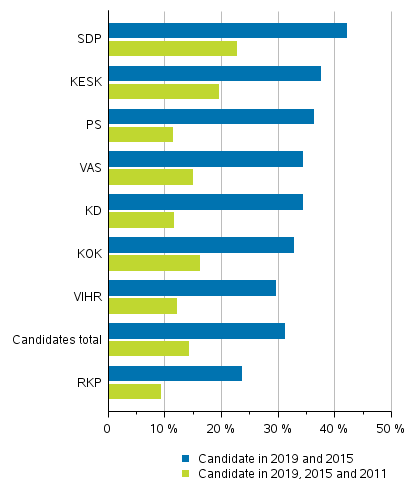
1.3. Age structure
Candidates are, on average, 4.3 years younger than persons entitled to vote
The average age of male candidates is 47.9 years and that of female candidates 45.5 years. On average, female candidates are nearly seven years younger than persons entitled to vote and male candidates around two years younger. The average age of persons entitled to vote has risen by around one year since the previous Parliamentary elections. On the day of the election, the average age of persons entitled to vote is now 49.8 for men and 52.3 for women.
The age structure of the candidates is very different from that of persons entitled to vote. The age pyramid of neither group is no longer a pyramid as the name indicates. The pyramid of persons entitled to vote is fairly uniform up to those aged 74, after which the age groups shrink considerably. The pyramid of the candidates shows the majority of men in all age groups and the fact that the youngest and oldest age groups are missing. There are most male candidates aged 35 to 39 and 55 to 59. For female candidates, the focus is between the ages 40 to 54.
Figure 3. Age distributions of persons entitled to vote by sex in Parliamentary elections 2019, % of all persons entitled to vote
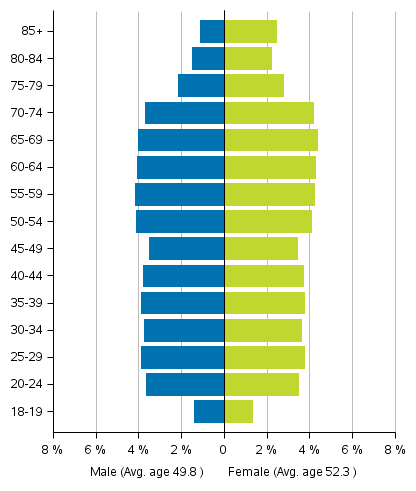
Figure 4. Age distributions of candidates by sex in Parliamentary elections 2019, % of all candidates
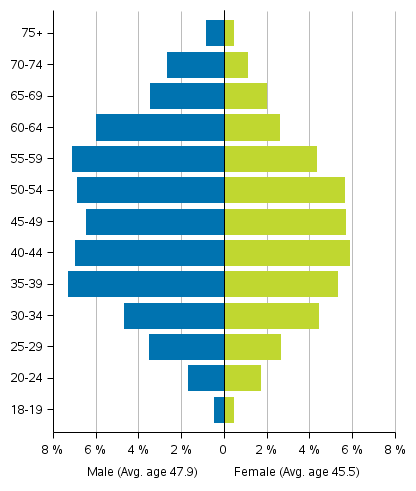
Blue Reform candidates oldest
Of the parliamentary parties, the Blue Reform has the oldest candidates: the average age of their candidates is 54.4 years and around 38 per cent of the candidates are aged 60 or over. The candidates of the Green League are in turn youngest in their average age. Around 15 per cent of them are aged under 30, and the average age of the candidates is 41.3 years. The Swedish People's Party has the most candidates aged under 30, slightly over 17 per cent, which is almost the same as the share of persons aged under 30 among all persons entitled to vote. Around 10 per cent of all candidates are aged under 30 and 19 per cent are aged 60 or over. Only three parties, the Green League, the Swedish People's Party and the National Coalition Party have more candidates aged under 30 than those aged 60 or over.
Figure 5. Persons entitled to vote and candidates (by party) by age group in Parliamentary elections 2019, %
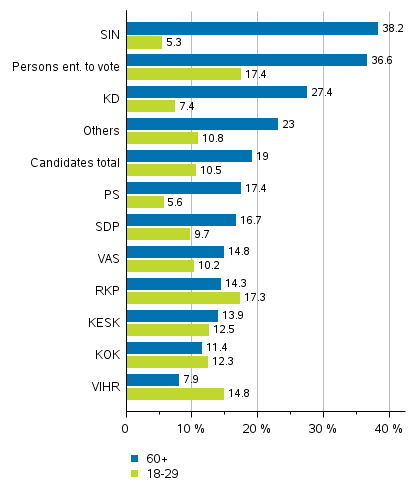
Table 4. Average age of persons entitled to vote and candidates (by party) by sex in Parliamentary elections 2019
| Male | Female | Total | |
| Persons ent. to vote | 49.8 | 52.3 | 51.1 |
| Candidates total | 47.9 | 45.5 | 46.9 |
| Centre Party of Finland KESK | 46.4 | 44.8 | 45.7 |
| National Coalition Party KOK | 46.9 | 43.6 | 45.4 |
| Finnish Social Democratic Party SDP | 47.2 | 43.9 | 45.6 |
| Left Alliance VAS | 44.9 | 43.7 | 44.3 |
| Green League VIHR | 43.0 | 40.3 | 41.3 |
| Christian Democrats in Finland KD | 51.7 | 50.9 | 51.3 |
| Swedish People’s Party in Finland RKP | 47.3 | 41.2 | 44.0 |
| Finns Party PS | 49.1 | 45.8 | 48.1 |
| Blue Reform SIN | 54.2 | 54.7 | 54.4 |
| Others | 47.7 | 47.7 | 47.7 |
1.4. Foreign background
2.3 per cent of candidates foreign language speakers
The share of foreign-language speakers among the candidates is on the same level as among persons entitled to vote. Of the candidates, 2.3 per cent are foreign-language speakers and 2.4 per cent of the persons entitled to vote speak a foreign language as their native language. The proportion of foreign-language speaking candidates is almost on the same level starting from the 2011 Parliamentary elections, even though the share of foreign-language speakers entitled to vote has grown. In the 2011 elections, the relative share of foreign-language speakers was higher among candidates than among persons entitled to vote. Over 60 per cent of foreign-language speaking candidates are running in the constituencies of Helsinki or Uusimaa.
There are also slightly more Swedish-speaking candidates than persons entitled to vote. Of the persons entitled to vote, 5.2 per cent speak Swedish as their native language, while 6.0 per cent of the candidates do. In Mainland Finland, the Swedish-speaking candidates are focused on the constituencies of Vaasa, Helsinki, Uusimaa and Varsinais-Suomi.
Table 5. Persons entitled to vote and candidates by sex and language in Parliamentary elections 2019, %
| Male | Female | Total | ||
| Persons ent. to vote | Finnish, sami | 92.2 | 92.2 | 92.2 |
| Swedish | 5.4 | 5.1 | 5.2 | |
| Other language | 2.3 | 2.6 | 2.4 | |
| Unknown | 0.1 | 0.1 | 0.1 | |
| Total | 100.0 | 100.0 | 100.0 | |
| Candidates total | Finnish, sami | 91.4 | 90.8 | 91.2 |
| Swedish | 5.3 | 6.9 | 6.0 | |
| Other language | 2.6 | 1.9 | 2.3 | |
| Unknown | 0.7 | 0.3 | 0.5 | |
| Total | 100.0 | 100.0 | 100.0 | |
The Green League, the Left Alliance and the Social Democratic Party have the most foreign-language speaking candidates, 3.7 per cent. In turn, the number of foreign-language speaking candidates is lowest in the Finns Party, the Swedish People's Party and the Christian Democrats, around one per cent or lower.
Figure 6. Foreign-language speakers’ proportion of persons entitled to vote and candidates (by party) in Parliamentary elections 2019, %
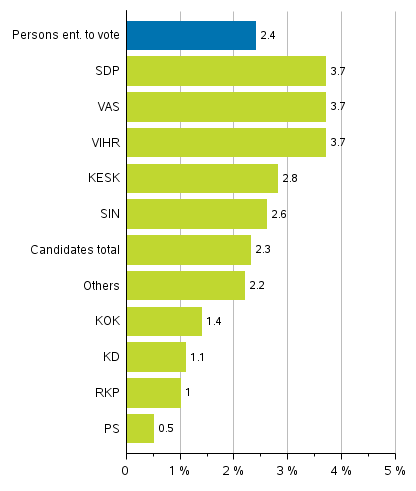
In all, 2.4 per cent of the candidates are of foreign origin
The foreign background of the population can also be examined by the person's origin. Persons, whose both parents (or only parent) have been born abroad, are defined as persons of foreign origin. In the Parliamentary elections 2019, altogether 2.4 per cent of the candidates and 2.5 per cent of persons entitled to vote are of foreign origin. Compared with the previous elections, the proportion of persons of foreign origin has grown among persons entitled to vote, but remained on the same level among the candidates. The proportion of persons of foreign origin among all persons living in Finland is, however, higher, as only Finnish citizens are entitled to vote and eligible to stand as candidates in the Parliamentary elections. For example, around seven per cent of the population living in Finland were of foreign origin in 2017.
Figure 7. The proportion of persons of foreign origin among persons entitled to vote and candidates in Parliamentary elections 2007, 2011, 2015 and 2019, %
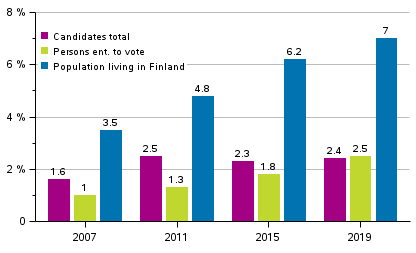
Latest data concerning the population living in Finland is from at the end of 2017
Of the parliamentary parties, the Social Democratic Party, the Left Alliance (4.2%) have the most candidates of foreign origin. Of the parliamentary parties, the Finns Party has the least candidates of foreign origin, around half a per cent of the nominated candidates.
Figure 8. Proportion of persons entitled to vote and candidates (by party) of foreign origin in Parliamentary elections 2019, %
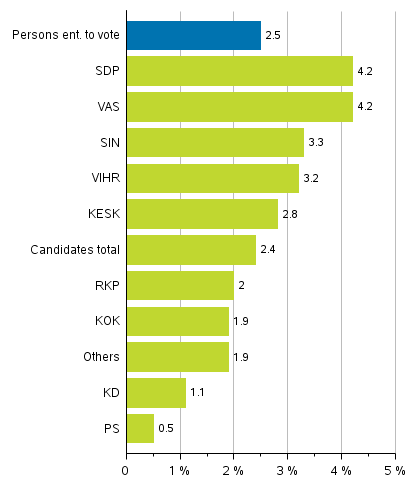
1.5. Educational level
More and more highly educated people are seeking entry to the Parliament
Highly educated people are seeking entry to the Parliament. The education level of candidates has risen from one election to another. In the 2007 elections, around 14 per cent of candidates had only basic level education and in the 2015 elections, slightly under 10 per cent and now in the 2019 elections, 8.5 per cent have only basic level education. Correspondingly, the share of candidates with tertiary level qualifications has increased from the 2007 elections by around nine percentage points, from 39 to 48 per cent.
Of persons entitled to vote, around 23 per cent have tertiary level qualifications and 24 per cent have only basic level education.
The candidates of the Green League and the Coalition Party have the highest level of education, one-half of them have higher tertiary or doctorate level degrees. The number of candidates with this level of education is lowest among the candidates of the Finns Party (17.4%), the Blue Reform and the Left Alliance (in both around 23%).
Table 6. Persons entitled to vote and candidates (by party) by educational level in Parliamentary elections 2019, %
| Basic level | Upper secondary level | Lowest level tertiary | Lower-degree tertiary | Higher-degree level tertiary, doctorate | Total | |
| Persons ent. to vote | 24.0 | 43.5 | 10.0 | 11.8 | 10.7 | 100.0 |
| Candidates | ||||||
| Candidates total | 8.5 | 34.0 | 9.4 | 16.1 | 32.1 | 100.0 |
| Centre Party of Finland KESK | 2.3 | 22.7 | 13.4 | 19.0 | 42.6 | 100.0 |
| Finns Party PS | 10.8 | 43.7 | 10.3 | 17.8 | 17.4 | 100.0 |
| National Coalition Party KOK | 2.8 | 18.5 | 10.9 | 15.2 | 52.6 | 100.0 |
| Finnish Social Democratic Party SDP | 6.0 | 29.2 | 11.6 | 19.0 | 34.3 | 100.0 |
| Green League VIHR | 3.7 | 19.9 | 4.6 | 17.1 | 54.6 | 100.0 |
| Left Alliance VAS | 5.1 | 44.4 | 5.1 | 22.2 | 23.1 | 100.0 |
| Swedish People’s Party in Finland RKP | 5.1 | 26.5 | 4.1 | 18.4 | 45.9 | 100.0 |
| Christian Democrats in Finland KD | 5.8 | 22.1 | 12.6 | 15.8 | 43.7 | 100.0 |
| Blue Reform SIN | 11.2 | 37.5 | 17.1 | 11.2 | 23.0 | 100.0 |
| Others | 14.9 | 44.6 | 8.0 | 12.8 | 19.7 | 100.0 |
1.6. Labour market position
A majority of candidates are in working life
The biggest difference in the main activity of candidates and persons entitled to vote is found in the share of employed persons and pensioners. The latest statistical data on the population’s main type of activity are from the end of 2017. At that time, a little over one-half of all persons entitled to vote were employed, while over 70 per cent of the candidates were employed. There are, in turn, clearly more pensioners among persons entitled to vote than among candidates, i.e. around 32 per cent. Around one in ten of the candidates are pensioners. The difference is mainly caused by the age structure. Of the candidates, around ten per cent are aged 65 or over, while 28 per cent of the persons entitled to vote have turned 65. If the candidates are compared with the persons entitled to vote aged under 65, the difference between the candidates and persons entitled to vote decreases.
Over 90 per cent of the Coalition Party and Centre Party candidates are employed. In addition, over 80 per cent of the Social Democratic Party, Green League, Swedish People's Party and Finns Party candidates are working. Of the parliamentary parties, the share of employed persons is lowest for the candidates of the Blue Reform, where around 60 per cent were employed at the end of 2017. The share of pensioners is nearly triple for candidates outside the parliamentary parties (18.5%) compared with the parliamentary parties (6.7%). Of the parliamentary parties, the Blue Reform (23.7%) and the Swedish People's Party (11.1%) have the most pensioner candidates.
The number of students is slightly higher among persons entitled to vote and that of unemployed persons slightly lower than among the candidates. The Swedish People's Party has the most student candidates and the Left Alliance and the Blue Reform have the most unemployed candidates.
Figure 9. Persons entitled to vote and candidates (by party) by main type of activity in Parliamentary elections 2019, %
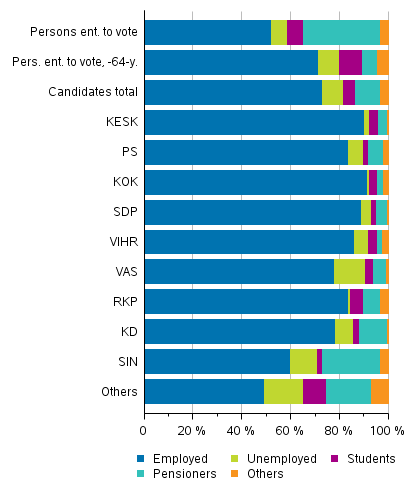
Table 7. Persons entitled to vote and candidates (by party) by main type of activity in Parliamentary elections 2019, %
| Employed | Unemployed | Students | Pensioners | Others | Total | |
| Persons ent. to vote | 52.3 | 6.3 | 6.5 | 31.6 | 3.3 | 100.0 |
| Pers. ent. to vote, -64-y. | 71.5 | 8.7 | 9.1 | 6.3 | 4.5 | 100.0 |
| Candidates total | 72.9 | 8.9 | 4.8 | 10.3 | 3.2 | 100.0 |
| Centre Party of Finland KESK | 90.3 | 1.9 | 3.7 | 3.7 | 0.5 | 100.0 |
| Finns Party PS | 83.6 | 6.1 | 2.3 | 6.1 | 1.9 | 100.0 |
| National Coalition Party KOK | 91.5 | 0.9 | 3.3 | 2.4 | 1.9 | 100.0 |
| Finnish Social Democratic Party SDP | 88.9 | 4.2 | 1.9 | 4.6 | 0.5 | 100.0 |
| Green League VIHR | 86.1 | 5.6 | 3.7 | 2.3 | 2.3 | 100.0 |
| Left Alliance VAS | 77.8 | 13.0 | 3.2 | 5.1 | 0.9 | 100.0 |
| Swedish People’s Party in Finland RKP | 83.7 | 1.0 | 5.1 | 7.1 | 3.1 | 100.0 |
| Christian Democrats in Finland KD | 78.4 | 7.4 | 2.6 | 11.1 | 0.5 | 100.0 |
| Blue Reform SIN | 59.9 | 11.2 | 2.0 | 23.7 | 3.3 | 100.0 |
| Others | 49.3 | 16.1 | 9.1 | 18.5 | 7.0 | 100.0 |
The employment rate refers to the ratio of employed persons to the population of a particular age, usually the age group 15 to 64 is used. Here, the employment rate has been calculated for the age group 18 to 64. The employment rate of persons entitled to vote is 71.5 per cent. The employment rate of the candidates is clearly higher. The employment rate of all candidates is 78.6 per cent. The employment rate is highest among the candidates of the Coalition Party, the Centre Party and the Social Democratic Party: their employment rate is around 93 per cent. The Blue Reform candidates have the lowest employment rate among the parliamentary parties, 71.3 per cent.
Women's employment rate is usually higher. The employment rate of women entitled to vote is 2.4 percentage points higher than that of men, and the rate of women candidates is four percentage points higher than that of men candidates. There are, however, differences between the parties. Women's employment rate is higher than men's for the candidates of the Finns Party, the Green League, the Centre Party, the Social Democratic Party and the Blue Reform. The employment rate is highest of all for the women candidates of the Finns Party, 95 per cent.
Figure 10. Employment rate of persons entitled to vote and candidates by party in Parliamentary elections 2019, share of employed persons aged 18 to 64, %
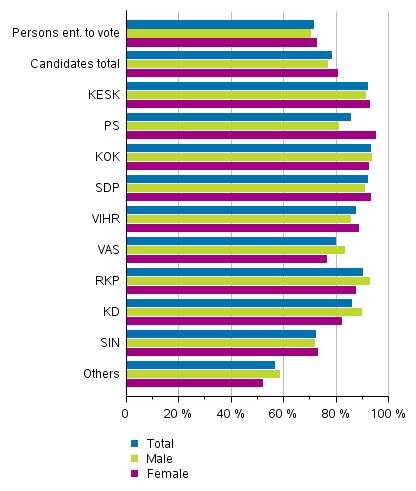
Majority of employed candidates salaried employees
Seventy per cent of employed candidates are salaried employees. Around 59 per cent of employed persons entitled to vote belong to this group. The Swedish People's Party and the Christian Democrats have the most salaried employees (around 80 per cent) as candidates. For all parliamentary parties, the proportion of salaried employees is higher among candidates than among persons entitled to vote. However, the number of salaried employees among candidates of parties outside the parliament and constituency associations is clearly lower than in the parliamentary parties.
One in ten persons entitled to vote and slightly more of the candidates (12%) are self-employed. Among the parliamentary parties, the most candidates with entrepreneurial background can be found in the Blue Reform and the Centre Party. The socio-economic group of 28 per cent of persons entitled to vote is manual worker. A clearly smaller proportion of candidates belong to this group (12.4%). The Left Alliance (22%) and the Social Democratic Party have most worker (18.4%) candidates.
Figure 11. Persons entitled to vote and candidates (by party) by socio-economic group in Parliamentary elections 2019, %
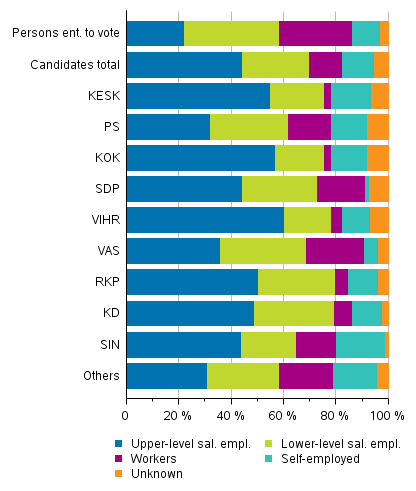
The central government sector employs candidates more than persons entitled to vote
Of employed candidates, 43 per cent work in the public sector. Roughly the same proportion of candidates and persons entitled to vote work in the local government sector but the central government sector employs clearly more MP candidates than persons entitled to vote. When around five per cent of all persons entitled to vote work in the central government sector, among candidates their proportion is nearly one-fifth. This is largely explained by the fact that 165 of the candidates are Members of Parliament who are thus employed by the central government sector. If we only examine candidates who are not Members of Parliament at the moment, the proportion of employees in the central government sector is still emphasised among candidates: 10.6 per cent of new candidates work in the central government sector.
The employer sector of the candidates varies significantly by party. The National Coalition Party and the Centre Party of Finland have the most candidates, around 27 per cent, working in the central government sector and the Christian Democrats in Finland (11.0%) and Left Alliance (11.6%) have least. The most local government sector employees can be found among the candidates of the Finnish Social Democratic Party, the Left Alliance and the Green League, good one-third of the candidates. The most private sector employees among candidates can be found in the Swedish People's Party and the Christian Democrats (was: Left Alliance), more than half of the candidates. The Blue Reform (18.7%) and the Centre Party of Finland (15.5%) have the most self-employed candidates.
Figure 12. Persons entitled to vote and candidates (by party) by employer sector in Parliamentary elections 2019, %
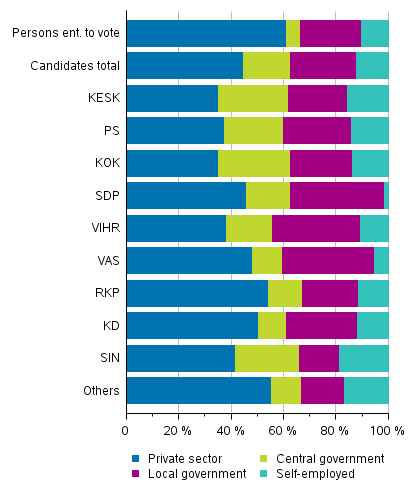
1.7. Family status
One-quarter of persons entitled to vote and one-fifth of candidates live alone
The candidates also differ in their family status from persons entitled to vote: considerably more of them are parents of a family with children and clearly fewer are childless couples than is the case among persons entitled to vote. This is of course explained by that the age structure of candidates is younger than among persons entitled to vote. For a majority of those entitled to vote, children have already moved from home, while most candidates are at an age when children are still living at home.
Of all persons entitled to vote, around 20 per cent are parents living in two-parent families. Nearly three per cent of all persons entitled to vote are single parents. Of persons entitled to vote, approximately 38 per cent are childless couples, close on 26 per cent live alone without a family, and around five per cent are young adults living at home with their parents. The remaining roughly nine per cent are persons without a family living together with some others, are homeless or in the institutional population.
The National Coalition Party (44.1%) and the Social Democratic Party (38%) have the most candidates that are parents living in two-parent families. The Blue Reform has the least candidates who are parents of a married/cohabiting family, only one-fifth of their candidates belong to this group. Of all candidates, 5.0 per cent are single parents. Their share is biggest among the Green League (7.4%) and Left Alliance candidates (6.5%).
Figure 13. Persons entitled to vote and candidates (by party) by family status in Parliamentary elections 2019, %
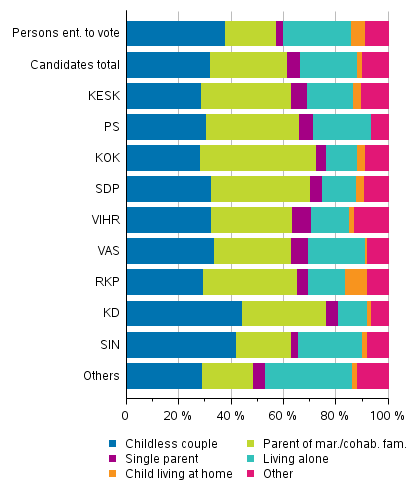
The Swedish People's Party in Finland (8.2%) has the most candidates that are young adults living at home with their parents. The Blue Reform has the highest number of candidates living alone without a family, around one quarter or the same number as people living alone among persons entitled to vote.
Candidates of the Christian Democrats in Finland have most childrenAlthough the majority of persons entitled to vote and many candidates are not at the moment going through the everyday life of a family with children, it does not mean that they do not have experiences of it. Thirty-four per cent of persons entitled to vote have never had or do not yet have children of their own, while about 30 per cent of the candidates are completely childless. The Christian Democrats have the lowest proportion of candidates without children, around 20 per cent.
Figure 14. Persons entitled to vote and candidates (by party) by number of children in Parliamentary elections 2019, %
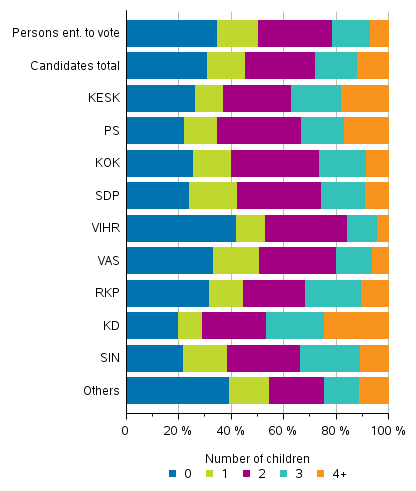
On average, female candidates have 1.8 children and male candidates 1.7 children. Women entitled to vote have, on average, 1.6 children and men 1.4. These figures include all biological and adopted children of the person regardless of their age or whether they still live at home.
1.8. Income level
Candidates’ income level higher than that of persons entitled to vote
The following examines the persons entitled to vote and the candidates by their disposable income. The income data derive from the latest taxation data from 2017. Disposable monetary income refers to the monetary income after taxes that consists of earned income, property income, and transfer income.
Candidates are more highly educated and a larger share of them are also working than among persons entitled to vote. This largely explains why their income level is also higher than that of persons entitled to vote. The median disposable income of the candidates is EUR 29,100 and that of all persons entitled to vote EUR 21,500. The candidates' disposable income is about 36 per cent higher than that of persons entitled to vote.
The National Coalition Party candidates have the biggest income difference with persons entitled to vote, as their disposable income is over two times higher compared with persons entitled to vote. The income of candidates in the Centre Party of Finland, the Swedish People's Party and the Social Democratic Party is also at least 70 to 80 per cent higher than that of those entitled to vote. Of the parliamentary parties, the Blue Reform is closest to the voters with a disposable income of EUR 26,300.
Figure 15. Median disposable income of persons entitled to vote, candidates (by party) and elected MPs in Parliamentary elections 2019, EUR per year
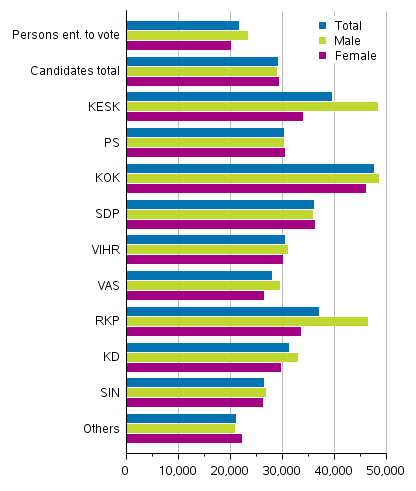
Candidates from the National Coalition Party have the highest income
When the population entitled to vote is arranged according to the income of 2017 and divided into ten equal parts, the income deciles of the population entitled to vote are generated. Each decile contains around 425,000 persons. The highest income decile of the population entitled to vote has at least EUR 39,600 at their disposal and the lowest income decile at most EUR 9,400.
Of all candidates, 27 per cent belong to the highest income decile. Of the candidates, those representing the National Coalition Party and the Centre Party belong to the higher end of the income distribution. Sixty-six per cent of male candidates and 57 per cent of female candidates in the National Coalition Party belong to the highest income decile. Among the candidates of the Centre Party, around 58 per cent of men and 41 per cent of women belong to the highest income decile.
Figure 16. Candidates (by party) belonging to the highest income decile in Parliamentary elections 2019, % of the party’s candidates (disposable monetary income)
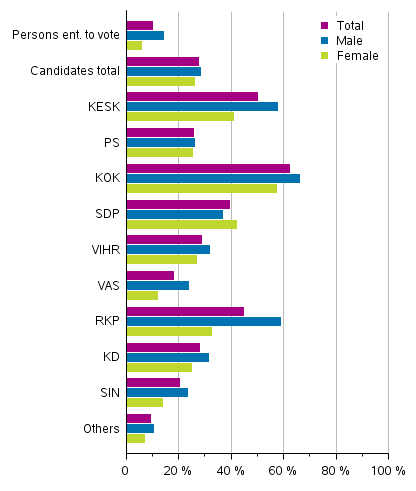
There are fewer women in the highest income decile both among persons entitled to vote and candidates. The biggest difference between sexes is found among the Swedish People's Party, Centre Party and Left Alliance candidates. In these parties, there are over ten percentage points more men in the highest income decile than women. Only the Social Democratic Party has an opposite setting: 42 per cent of its female candidates and 37 per cent of its male candidates belong to the highest income decile.
Figure 17. Candidates (by party) belonging to the lowest income decile in Parliamentary elections 2019, % of the party’s candidates (disposable monetary income)
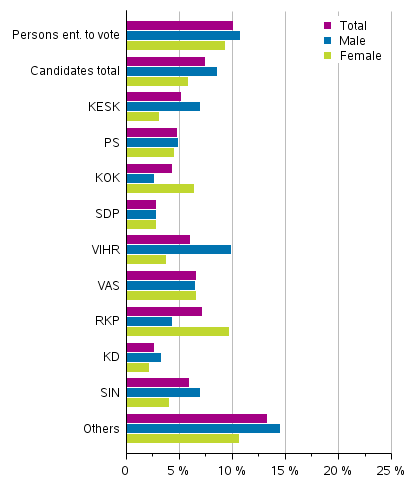
There are also more men than women in the lowest income decile, but the differences between women and men are smaller than among those belonging to the highest income bracket. Female candidates in the Swedish People's Party and the National Coalition Party are an exception here: More of them belong to the lowest income bracket than their parties’ male candidates.
Table 8. Candidates belonged to the highest and lowest-income decile by party in Parliamentary elections 2019, % of the party’s candidates
| Lowest-income decile | Highest-income decile | |||||
| Male | Female | Total | Male | Female | Total | |
| Persons ent. to vote | 10.7 | 9.3 | 10.0 | 14.2 | 6.0 | 10.0 |
| Candidates total | 8.5 | 5.8 | 7.4 | 28.4 | 26.2 | 27.4 |
| Centre Party of Finland KESK | 6.9 | 3.0 | 5.1 | 57.8 | 41.0 | 50.0 |
| Finns Party PS | 4.8 | 4.5 | 4.7 | 26.0 | 25.4 | 25.8 |
| National Coalition Party KOK | 2.6 | 6.3 | 4.3 | 66.1 | 57.3 | 62.1 |
| Finnish Social Democratic Party SDP | 2.8 | 2.8 | 2.8 | 36.7 | 42.1 | 39.4 |
| Green League VIHR | 9.8 | 3.7 | 6.0 | 31.7 | 26.9 | 28.7 |
| Left Alliance VAS | 6.4 | 6.5 | 6.5 | 23.9 | 12.1 | 18.1 |
| Swedish People’s Party in Finland RKP | 4.3 | 9.6 | 7.1 | 58.7 | 32.7 | 44.9 |
| Christian Democrats in Finland KD | 3.2 | 2.1 | 2.6 | 31.2 | 24.7 | 27.9 |
| Blue Reform SIN | 6.9 | 4.0 | 5.9 | 23.5 | 14.0 | 20.4 |
| Others | 14.4 | 10.6 | 13.2 | 10.3 | 7.1 | 9.3 |
Source: Parliamentary Elections 2019, nomination of candidates. Statistics Finland
Inquiries: Sami Fredriksson 029 551 2696, Kaija Ruotsalainen 029 551 3599, vaalit@stat.fi
Director in charge: Jari Tarkoma
Updated 5.4.2019
Official Statistics of Finland (OSF):
Parliamentary elections [e-publication].
ISSN=1799-6279. Nomination of candidates and background analysis of candidates 2019,
1. Background analysis of candidates in the Parliamentary elections 2019
. Helsinki: Statistics Finland [referred: 22.12.2025].
Access method: http://stat.fi/til/evaa/2019/01/evaa_2019_01_2019-04-05_kat_001_en.html

